dry machinery plays a critical role in industries such as food processing, pharmaceuticals, and chemicals, ensuring products are dehydrated, preserved, and prepared for packa
dry machinery plays a critical role in industries such as food processing, pharmaceuticals, and chemicals, ensuring products are dehydrated, preserved, and prepared for packaging or further use. Below is a comprehensive solution highlighting key dry machinery types and their applications, designed to address modern dehydration challenges.
Versatile for bulk materials like grains, minerals, and biomass:
- Cylindrical rotating drums with internal flights to agitate materials.
- Direct/indirect heating options (e.g., steam, gas, or electric).
- IoT-connected sensors monitoring temperature and moisture in real time.
Example Use Case: A grain mill in Canada uses a rotary dryer to reduce wheat moisture from 18% to 12% in 30 minutes.
Ideal for powders, granules, and tablets:
- Air jets suspend materials for uniform heat distribution.
- Modular designs for batch or continuous processing.
- Energy-efficient due to minimal heat loss.
Benefit: A pharmaceutical plant in India cuts drying time by 40% for active pharmaceutical ingredients (APIs).
Transform liquids into powders (e.g., milk, juices, detergents):
- Nozzle atomization creating micro-droplets for rapid evaporation.
- Cyclone separators collecting dried particles.
- Automated control systems adjusting inlet/outlet temperatures.
Impact: A dairy company in the Netherlands produces 500kg/h of milk powder with consistent particle size.
Gentle drying for heat-sensitive products:
- Low-pressure chambers lowering boiling points to preserve nutrients.
- Jacketed vessels for precise temperature control.
- FDA-compliant materials for food and medical applications.
Result: A herbal extract manufacturer in China retains 95% of active compounds in dried products.
Cost-effective for small batches and laboratory settings:
- Stackable trays holding materials (e.g., fruits, vegetables, textiles).
- Forced-air circulation ensuring even drying.
- Solar-powered models for sustainable off-grid operations.
Success Story: A craft brewery in the UK uses tray dryers to dehydrate hops for flavor consistency.
Thin-film drying for pastes and slurries:
- Steam-heated rotating drums evaporating moisture rapidly.
- Scraper blades removing dried product as flakes/powder.
- Customizable drum sizes for high-capacity production.
Outcome: A starch processing plant in Thailand achieves 90% water removal in seconds.
Premium drying for biologics, vaccines, and gourmet foods:
- Sub-zero freezing followed by vacuum sublimation.
- Hermetic chambers maintaining sterile environments.
- AI algorithms optimizing drying cycles for energy efficiency.
Example: A biotech firm in the U.S. preserves monoclonal antibodies with 99% bioactivity.
- Product Quality: Gentle drying preserves nutrients, flavors, and active ingredients.
- Energy Savings: Advanced designs reduce electricity/gas consumption by 30–50%.
- Scalability: Adaptable to small-scale artisanal production and industrial lines.
- Sustainability: Closed-loop systems minimize waste and CO₂ emissions.
- High Initial Costs: Leasing options and government grants for SMEs.
- Technical Complexity: User-friendly touchscreen interfaces and remote troubleshooting.
- Maintenance: Predictive analytics detecting equipment wear before failures.
Conclusion
In 2025, dry machinery is essential for industries requiring precise dehydration, extended shelf life, and product preservation. By adopting smart, energy-efficient solutions, businesses can enhance product quality, reduce operational costs, and align with global sustainability goals.
For tailored drying systems, consult a certified equipment manufacturer or process engineer.


